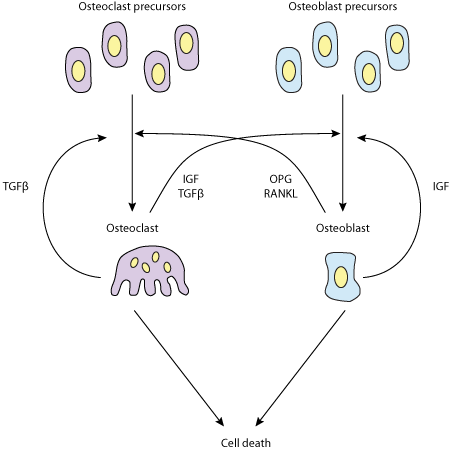Komarova, Smith, Dixon, Sims, Wahl, 2003
Model Status
This CellML model runs in both OpenCell and COR to recreate the published results (figure 2). The parameter values have been set to those in the legend of figure 2. Note there appears to be a typographical error in equation A2 in the published paper: 1-(g11/gamma) has been changed to (1-g11)gamma to be consistent with equations A1 and A3.
Model Structure
ABSTRACT: Bone remodeling occurs asynchronously at multiple sites in the adult skeleton and involves resorption by osteoclasts, followed by formation of new bone by osteoblasts. Disruptions in bone remodeling contribute to the pathogenesis of disorders such as osteoporosis, osteoarthritis, and Paget's disease. Interactions among cells of osteoblast and osteoclast lineages are critical in the regulation of bone remodeling. We constructed a mathematical model of autocrine and paracrine interactions among osteoblasts and osteoclasts that allowed us to calculate cell population dynamics and changes in bone mass at a discrete site of bone remodeling. The model predicted different modes of dynamic behavior: a single remodeling cycle in response to an external stimulus, a series of internally regulated cycles of bone remodeling, or unstable behavior similar to pathological bone remodeling in Paget's disease. Parametric analysis demonstrated that the mode of dynamic behavior in the system depends strongly on the regulation of osteoclasts by autocrine factors, such as transforming growth factor beta. Moreover, simulations demonstrated that nonlinear dynamics of the system may explain the differing effects of immunosuppressants on bone remodeling in vitro and in vivo. In conclusion, the mathematical model revealed that interactions among osteoblasts and osteoclasts result in complex, nonlinear system behavior, which cannot be deduced from studies of each cell type alone. The model will be useful in future studies assessing the impact of cytokines, growth factors, and potential therapies on the overall process of remodeling in normal bone and in pathological conditions such as osteoporosis and Paget's disease.
 |
| Schematic representation of interactions between osteoclasts and osteoblasts included in the model. Thick arrows represent the processes of formation and removal of osteoclasts and osteoblasts. Fine arrows represent the effects of autocrine and paracrine regulators of bone remodeling on the rates of osteoclast and osteoblast formation. TGF-beta, transforming growth factor beta, released and activated by resorbing osteoclasts, directly stimulates formation of osteoclasts and osteoblasts. IGF, insulin-like growth factors, secreted by osteoblasts and released by resorbing osteoclasts, activate osteoblast formation. RANKL, expressed on and released by osteoblasts, activates osteoclastogenesis. OPG, osteoprotegerin, released by osteoblasts, inhibits the actions of RANKL. |
The original paper reference is cited below:
Mathematical model predicts a critical role for osteoclast autocrine regulation in the control of bone remodeling, Komarova SV, Smith RJ, Dixon SJ, Sims SM, Wahl LM, 2003, Bone, 33, 206-215. PubMed ID: 14499354

